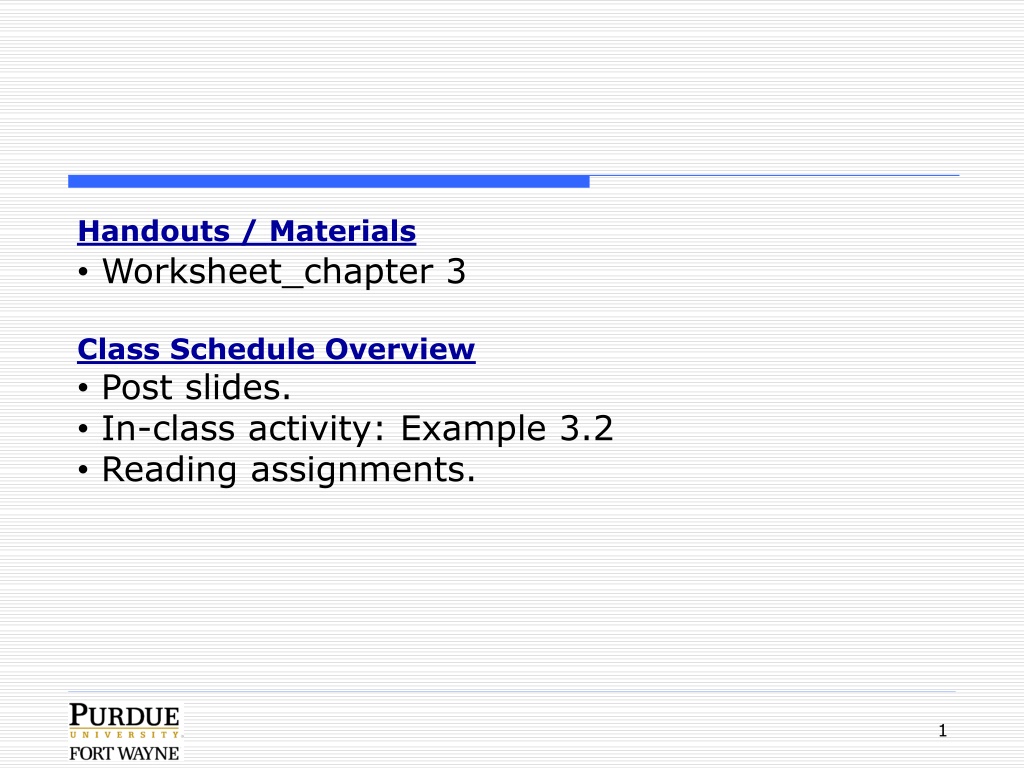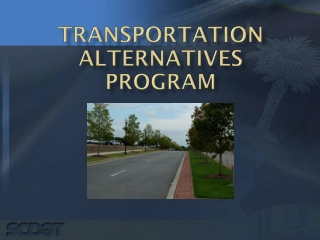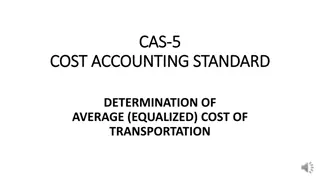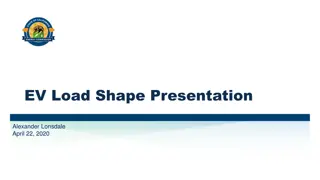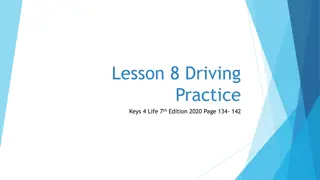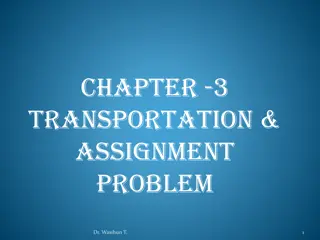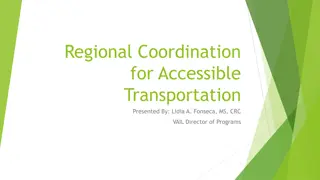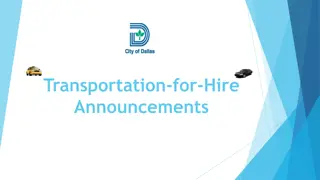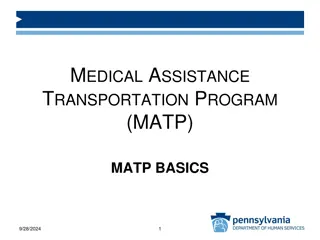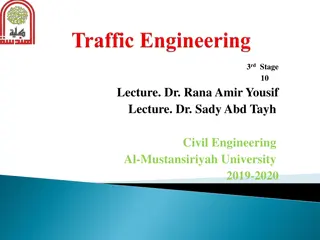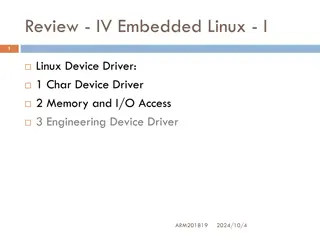Understanding Characteristics of Drivers and Pedestrians in Transportation Engineering
This material covers the characteristics of drivers, pedestrians, vehicles, and roads in transportation engineering. It explores what transportation engineers have control over and why studying these characteristics is essential. The content delves into driver regulations, sensory processes while driving, and the importance of visual and hearing abilities for drivers. Topics like visual acuity, dynamic acuity, and sensory perception are discussed in detail, providing valuable insights for transportation engineers.
- Transportation Engineering
- Driver Characteristics
- Pedestrian Behavior
- Vehicle Design
- Road Infrastructure
Download Presentation

Please find below an Image/Link to download the presentation.
The content on the website is provided AS IS for your information and personal use only. It may not be sold, licensed, or shared on other websites without obtaining consent from the author. Download presentation by click this link. If you encounter any issues during the download, it is possible that the publisher has removed the file from their server.
E N D
Presentation Transcript
Handouts / Materials Worksheet_chapter 3 Class Schedule Overview Post slides. In-class activity: Example 3.2 Reading assignments. 1
CE 34500 Transportation Engineering Chapter 3: Characteristics of the Driver, the Pedestrian, the Vehicle, and the Road 2
Characteristics of Driver, Pedestrian, Vehicle & Road As a Transportation Engineer, What Do We Have Control Over?
Characteristics of Driver, Pedestrian, Vehicle & Road If We Do Not Have Full Control Over All of the Characteristics, Why do We Study Them?
Driver Characteristics No Design Driver o Wide range of abilities Abilities vary under different conditions 85th to 95th percentile used for design criteria How Do We Regulate Drivers? o Driver licensing Minimum knowledge of the rules of the road Minimum driving ability Minimum physical ability
Driver Characteristics Human Response Process o Five senses See / Visual reception Hear / Hearing perception Touch / Kinesthetic / Equilibrium Smell Taste What Sensory Processes Do We Use When Driving?
Driver Characteristics Visual and Hearing Important o Visual most important Visual acuity Peripheral vision Color vision Glare vision & recovery Depth perception o Hearing less important Can compensate for deafness & operate vehicle safely
Visual Reception Visual Acuity o Ability to see fine details o Static acuity o Dynamic acuity Normal visual acuity taken as 20/20--an individual with a 20/20 visual acuity can distinguish a letter that is subtended by an angle of 5' of arc ( 1/12 of a degree) at the eye--0.35 in therefore represents the height of a 20/20 letter prove?
In Class Problem 1 Example 3.1: A driver with w visual acuity of 20/30 can just decipher a sign a distance 20 ft. from a sign. Determine the maximum distance from the sign at which drivers with the following visual acuity will be able to see the same sign: [Ans. 40, 12 ft.] 20/15 20/50
Visual Reception Peripheral Vision o Ability to see objects clearly beyond cone of clearest vision Color Vision o Ability to differentiate one color from another Glare Vision & Recovery o Decrease in visibility & comfort o Takes time to recover from glare effects Depth Perception o Ability to estimate distance
Perception Reaction Process Perception o Conscious awareness that something happened Identification o Acquire info. to make decision Emotion o Select appropriate action Volition o Execute selected action Perception-reaction time o Sum of PIEV times
Perception Reaction Time Perception Reaction Time o Varies among individuals o Varies for different situations o 85th percentile time ranges from 1.6 to 7.8 sec. for unexpected info. o Per AASHTO Green Book use 2.5 sec. for design (90th percentile value) o Used to determine reaction portion of braking distance
Perception Reaction Time What Does 2.5 Sec. Perception Reaction Time Mean in Terms of Roadway Design?
Perception Reaction Time In Class Problem 2 A driver with a perception reaction time of 2.5 sec is driving at 65 mph when she observes that an accident has blocked the road ahead. Determine the distance the vehicle would move before the driver could activate the brakes. The vehicle to continue to move at 65 mph during the perception reaction time of 2.5 sec. [Ans. 238.9 ft.]
Perception Reaction Time Use of Symbols in Roadway Signs o Standard symbols (v. wordy explanation) decreases perception-reaction time Slow Down. There is a curve ahead. Advise no more than 25 mph. 25 MPH
Perception Reaction Time Use of Symbols in Roadway Signs Slippery When Wet
Driver Expectancy Driver Expectancy o Drivers become conditioned to react in certain way in certain situation
Driver Expectancy When met: o Performance tends to be error free When violated: o Decisions take more time o Performance is poorer o Situation may cause crash
Older Drivers Changing Demographics
Older Drivers Diminished Visual Capabilities o Reductions in Acuity Ability to discriminate high contrast features o Reductions in Contrast Sensitivity Ability to detect low-contrast features o Reductions in Visual Field Reduced peripheral visions
Older Drivers Diminished Visual Capabilities o Restrictions in Area of Visual Attention Ability to discriminate relevant from irrelevant information o Increased Sensitivity to Glare Ability to see in the presence of oncoming headlights o Decreased Dark Adaptation Ability to see objects when moving from areas of light to dark o Decreased Motion Sensitivity Ability to determine how fast other vehicles are moving
Pedestrian Characteristics In What Situations Do Pedestrian Characteristics Most Affect Road Design? Pedestrian Walking Speeds o Speed varies between 3 & 8 ft/sec o 3.5 ft/sec used for design purposes o 3.0 ft/sec in areas with large elderly population
Pedestrian Characteristics Other Pedestrian Considerations o Allowance for handicapped pedestrians in design Americans with Disabilities Act (ADA) Audible info. / vibrating surfaces at intersections Wheelchair ramps at intersections and other ADA facilities
Bicyclists and Bicycles Three Classes of Bicyclists o Class A Experienced--comfortably ride in traffic o Class B Less experienced prefer to ride on neighborhood streets or bicycle paths o Class C Children w/ or w/o parents ride mainly on residential streets to schools, playgrounds, etc Design of Bicycle Facilities.
Driver Expectancy Mac Duff Mac Donald Mac Hinery
Driver Expectancy 3 6 9 ? 3 9 27 ? 3 14 159 ?
Vehicle Characteristics Maximum allowable sizes and weights on Interstates and Federal Aid Highways 80,000 lb. gross weight, o Axle loads up to 20,000 lb. for single axles o 34,000 lb. for tandem (double) axles 102 in. width for all trucks 48 ft. length for semitrailer and trailers 28 ft. length for each twin trailer
Vehicle Characteristics In-class Problem 2 A 5 axle truck traveling on an interstate highway has the following axle characteristics. o Distance bet ween the front single axle and the front set of tandem axles = 20 feet. o Distance between the front single axle and the back set tandem axle = 65 feet. o Distance between the front set of tandem axles and the back set of tandem axles = 48 feet. o Load carried by front set of single axles = 10000 lb o Load carried by each axle of the tandem-axles = 16000 lb Determine whether this truck satisfies federal weight regulations. 29
